

Most Popular Types of Sails on a Sailboat
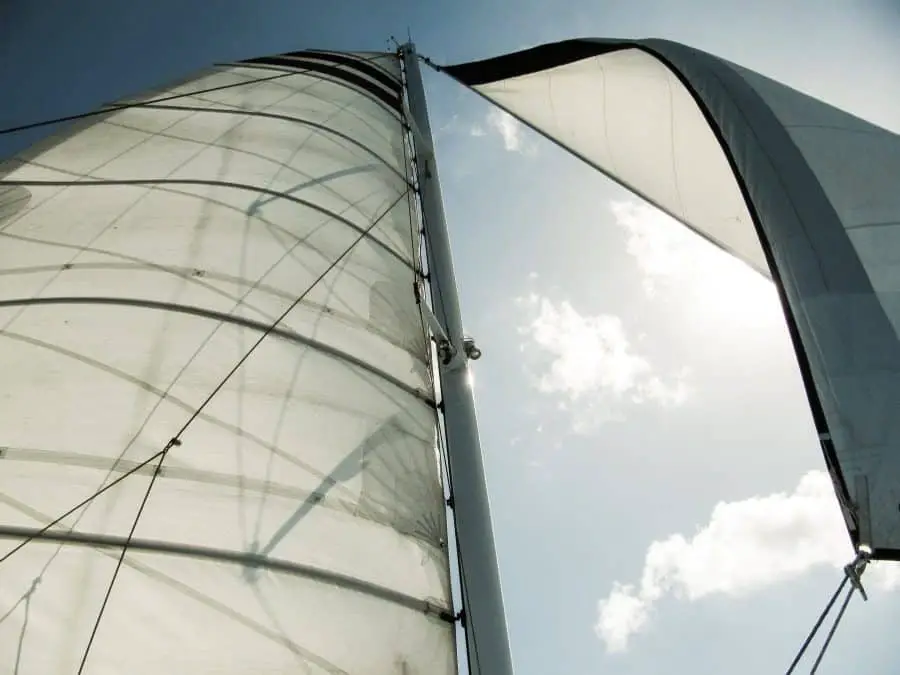
Learning about how there were different types of sails on sailboats for me was a bit strange at first. I thought something along the lines of “Don’t you just need to put some fabric on some polls and grab the wind?” Obviously, there’s far more to it than that.
So what are the most popular types of sails on sailboats? The mainsail, headsail (or jib), genoa, spinnaker, and gennaker are the most popular types of sails on sailboats. There are also a number of different configurations when considering the type of sail and mast in use including a sloop, fractional rig sloop, cutter, ketch, schooner, yawl, and cat.
Simply put, different sailboat sails serve different purposes when out on the water.
The sail is kind of like the “engine” of your sailboat (of course, sailboats can have actual engines) in that it’s the main source of forward propulsion.
So, it’s important to know when best to use either type of sail and why including the many different names of sails on a ship.
Types of Sails
There are a number of reasons why you’d want to use one sail over another, but the most important points to consider have to do with the point of sail you’re sailing in and the wind strength.
Maybe you need downwind sails, square sails, or a triangular sail. Maybe a unique sail shape, sail cloth, or sail area. With that in mind, let’s check out the different sail types!
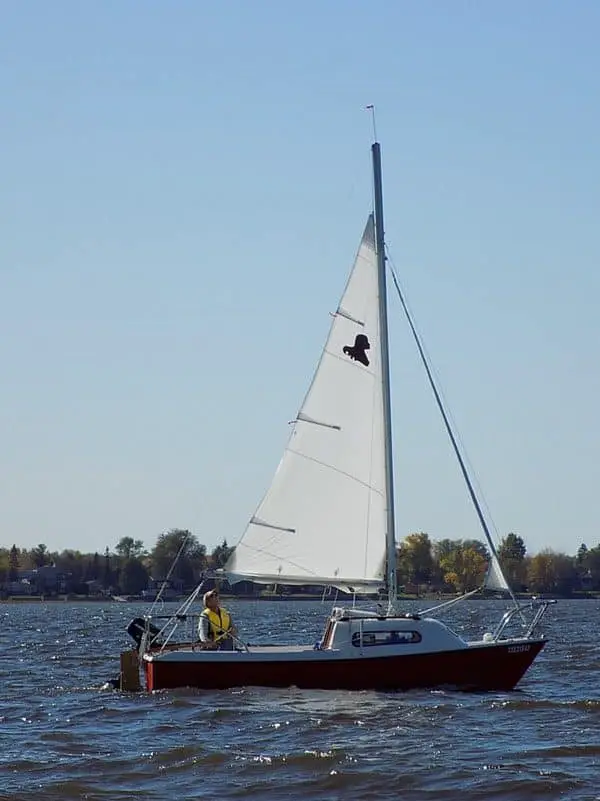
The mainsail is by far the most popular type of sail on sailboats and is often the first image that comes to mind when thinking about a sailboat.
Mainsails are found behind the mast and attached to the boom, which makes it a common part of the sailboat to keep an eye on as it takes up a lot of real estate on a boat with sails especially during a sail tack.
Mainsails are able to cover a lot of surface area with respect to incoming winds, especially since they’re attached to the boom.
The fact that they have a large surface area means they don’t require very strong winds to provide good forward propulsion on a sailboat.
Also, since the position of the mainsail can be easily configured thanks to the boom, all points of sail are achievable.
Headsail/Jib

The headsail (or jib) is probably the second most popular type of sail on sailboats since it usually accompanies the mainsail.
The headsail is always placed at the front of the mast and can cover a good amount of the bow of the sailboat. It’s also smaller than a mainsail, making it more portable and easy to work with.
Headsails aren’t as big as mainsails, therefore they have a smaller surface area which results in the fact that they’re not capable of catching as much wind as a mainsail.
This is an important point though since if the current wind is exceptionally strong and your mainsail has been trimmed as much as possible, being able to put away your mainsail and depend on your headsail alone is an excellent strategy to reduce speed.
When the wind is just too strong to keep your mainsail out, putting it away and using only your headsail is a great option.
You won’t be grabbing as much wind as with the mainsail and you’ll be able to have a much more enjoyable (and safer!) sailing experience.
One of the most picturesque sailing images one can conjure up is the one with a sailboat using a genoa sail (see the image above on the right).
A genoa is a type of large jib that’s attached to the front of the forestay just like a headsail.
One of the main differences with the genoa sail is that it’s bigger than the normal headsail and oftentimes extends behind the mast partially or completely covering the mainsail. It actually used to be called an “overlapping jib”.
Using a genoa sail means you have light to medium winds and your sailboat is more or less in a dead run point of sail (wind coming directly from the rear or sailing downwind).
Since the surface area of a genoa sail is so large, it’s important only to use it when winds are relatively low. Otherwise, you’ll be moving exceptionally fast resulting in a potentially risky situation.
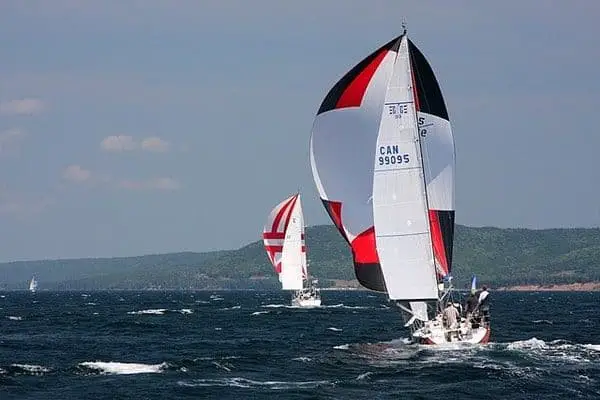
A spinnaker sail is a fun sail to use since it’s quite large, colorful, and can pick up a lot of wind.
Unlike a genoa sail, they’re often symmetrical making them more sensitive to the reaching points of sail and thus more appropriate for the running point of sail. They’re also lighter and have a “kite” kind of feel to them.
The reason they resemble a “kite” is not only that they’re generally lighter and more colorful than other types of jibs, but also they don’t cover the mast like a genoa sail.
Instead, they don’t attach to the forestay and stretch out toward and past the bow of a sailboat. Since they’re bigger than genoa sails, you want to be even more careful to only use them in relatively low and non-volatile wind environments.
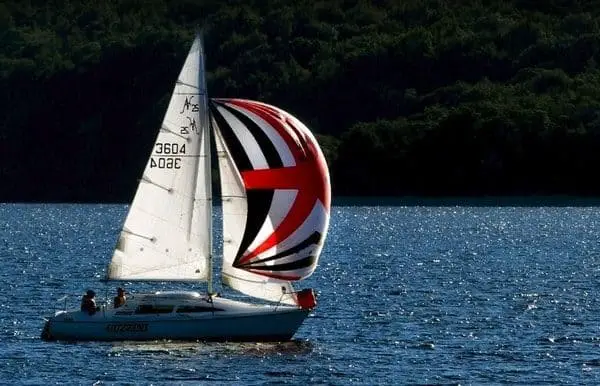
A gennaker sail is a more recent type of sail on sailboats since they were developed around 1990.
Gennakers are a cross between genoa and spinnaker sails (as the name might suggest), which are big like a spinnaker, aren’t as symmetric as a spinnaker, and aren’t attached to the forestay like a genoa sail or headsail.
The reason for the invention of the gennaker is that sailors wanted to take advantage of lighter winds without having to resort to using a spinnaker if the winds change from a pure dead run to more of a reaching point of sail.
All in all, the gennaker sail is able to bridge the performance gap between a genoa and spinnaker sail in terms of being able to take on a more flexible point of sail while taking advantage of relatively softer winds.
Popular Sail and Mast Configurations
Now that you’re familiar with the most popular types of sails on a sailboat, it’s good to get an idea of how these sail types relate to the configuration of a sailboat’s mast.
There are a huge number of combinations when it comes to sails and mast configurations, so I thought I’d lay out the most popular ones you’ll likely run into out on the water.
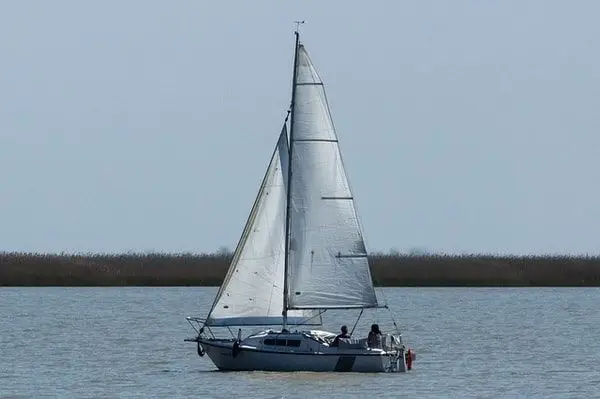
A sloop is the most common type of sail and mast configuration for sailboats. The sloop is the classic single mast, double sail setup.
The sails on a sloop consist of a mainsail and a headsail. The headsail can be different types of jibs, including the genoa, spinnaker, or gennaker sails. The headsail is connected to the forestay on the mast and runs all the way to the top of the mast.
Fractional Rig Sloop
Similar to a sloop, a fractional rig sloop has a single mast, double sail setup. The only difference, however, is that the forestay doesn’t reach the top of the mast, resulting in the headsail being restricted to a fractional amount of space a normal sloop would allow for.
This reduction of surface area for the headsail means that less wind can be captured and, thus, reduced sailboat speed.
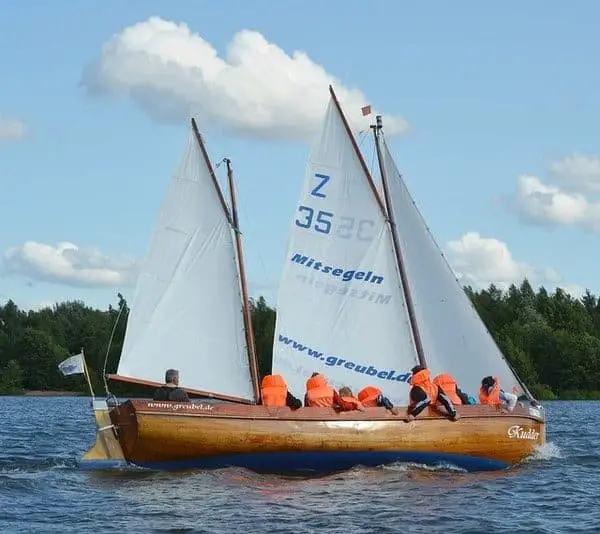
A cutter is an interesting setup since it’s just like the sloop and fractional rig sloop setup, but instead of one forestay it has two. With two forestays on the mast, cutters are able to house two headsails.
This can be a preferred setup because it allows for easy cruising due to it offering a diverse combination of points of sail for different strengths of wind.
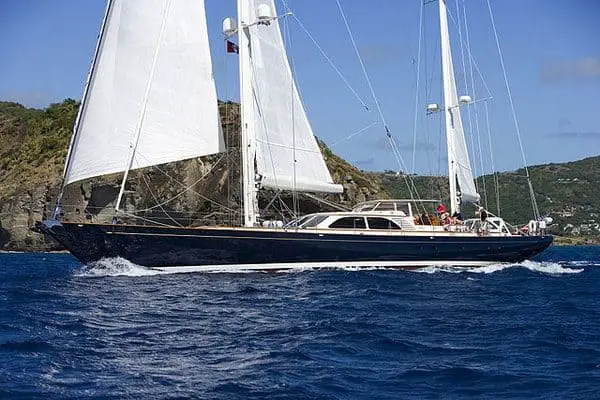
A ketch is a less common setup when compared to the previous setups since it has two masts.
Just like a sloop, it has a mast that allows for a mainsail and headsail with a full range forestay, but it also has a smaller sized mast between the mainmast and the stern of the sailboat.
This mast configuration was commonly used in Northern European freighter and fishing boats and is called the mizzen mast.
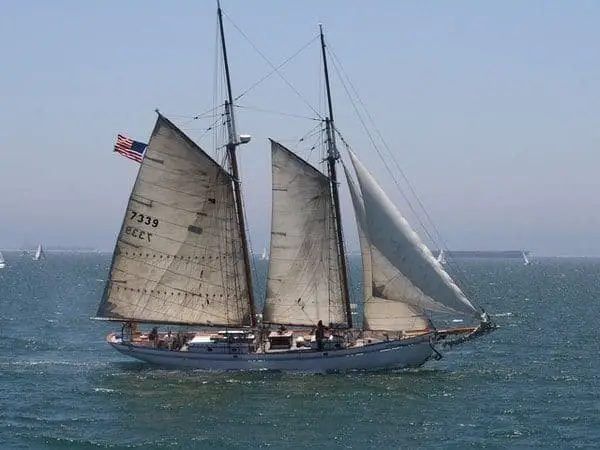
If you’ve ever seen Pirates of the Carribean, you’ll have seen almost nothing but schooners. A schooner is when a sailboat has two or more masts, similar to a ketch, while having a number of sails to manage.
The main differences between a ketch and a schooner are that a schooner’s aft mast (the rear mast) is taller than the forward mast and a schooner can have up to six masts some including a square sail or two. This makes names of sails on a schooner the fore and aft sail (or fore and aft rig).
A yawl is almost identical to a ketch with the only difference being that the mizzen mast is located directly behind the sailboat’s rudder post. In terms of a ketch vs yawl, the mizzen sail is also much smaller than the mizzen sail on a ketch due to its position on the sailboat.
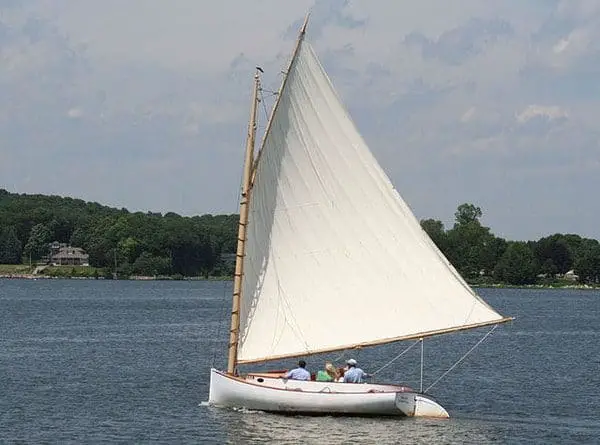
A cat has one mast and one sail with the mast being positioned at the bow of the sailboat. This mast configuration is most commonly found on smaller sailboats, especially dingy sailboats. These types of sailboats are colloquially called “catboats”.
Get the very best sailing stuff straight to your inbox
Nomadic sailing.
At Nomadic Sailing, we're all about helping the community learn all there is to know about sailing. From learning how to sail to popular and lesser-known destinations to essential sailing gear and more.
Quick Links
Business address.
1200 Fourth Street #1141 Key West, FL 33040 United States
Copyright © 2024 Nomadic Sailing. All rights reserved. Nomadic Sailing is a participant in the Amazon Services LLC Associates Program, an affiliate advertising program designed to provide a means to earn fees by linking to Amazon.com and affiliated sites.

Types of Sails: A Comprehensive Guide
In the enchanting world of sailboat dynamics, where the dance between wind and water takes center stage, the significance of sails cannot be overstated. Like the wings of a bird, these meticulously crafted sails unfurl to catch the slightest whisper of breeze, converting it into a powerful forward thrust that carries us through the vast expanse of the ocean. They are the very essence of a sailboat, the conduits through which dreams and aspirations set sail.
Join us on a captivating voyage as we unfurl the secrets of the myriad types of sails adorning the mastheads of sailboats across the globe. From the grandeur of the mainsail, proudly dominating the skyline, to the nimble headsails that steer with precision, and the enigmatic mizzensails that add an extra touch of finesse, we shall embark on a comprehensive exploration of the diverse array of sail types.
Different Types of Sails on a Sailboat: Why Use Different Sails at All?
Different sail types for different wind conditions.
Triangular sails, such as the mainsail and jib, are commonly used on modern sailboats to optimize performance when sailing upwind. The shape of these sails helps to create lift, which propels the boat forward even against the wind’s direction. The mainsail is attached to the mast at the front edge and a boom at the bottom. Jibs, on the other hand, are headsails that are attached to a stay near the bow of the boat.
Balloon sails, like spinnaker sails, are designed for downwind sailing and catching more wind to increase boat speed when sailing with the wind behind it. These types of sails have a large surface area that allows them to catch more wind than triangular sails. Spinnaker sails can come in different shapes depending on their intended use and can be flown from a spinnaker pole or directly from the bow.
Sail Plans: Different Combinations for Different Boats
Sail plans refer to how different types of sails are arranged and combined on a sailing craft. Sail plans can vary depending on specific design features and intended use of boats. For example, some boats may have multiple masts with several triangular-shaped sails attached while others may only have one mast with one triangular sail (mainsail) and one square sail (spinnaker). The combination of different types of sails can also affect how easy it is to handle a boat under certain conditions.
Understanding Sail Anatomy
Head, tack, foot, luff, leech, and clew. These are the different parts that make up a sail’s anatomy. But what exactly are they and why are they important? In this section, we’ll take a closer look at each part and how it contributes to the performance of a sailboat.

The Head: The Top of the Sail
Starting from the top, we have the head of the sail. This is where the halyard (the rope or wire used to hoist the sail) is attached. The head determines how high or low the sail sits on its mast. A higher head means more power but less control over the sail’s shape. Conversely, a lower head provides better control but less power.
The Tack: The Lower Front Corner of the Sail
Next is the tack which is found at the lower front corner of most sails. It’s where one end of a line called a “sheet” attaches to control how much wind enters through this corner of your sail. Adjusting your sheet will affect your boat’s speed and direction.
The Foot: The Bottom of the Sail
At the bottom edge of any sail lies its foot which helps determine its overall shape and size. Generally speaking, longer feet result in larger sails that provide more power while shorter feet result in smaller sails with better maneuverability.
The Luff: The Forward Edge of the Sail
The forward edge of any sail is called its luff which runs along its mast track or forestay depending on what type of rigging you have set up on your boat. It helps maintain proper airflow over your sails by keeping them from flapping around too much in high winds.
The Leech: The Back Edge of Your Sail
Opposite from your luff is your leech – or back edge – which helps create lift by allowing air to flow smoothly over your sail. A longer leech will result in a more powerful sail, while a shorter one will provide better control and maneuverability.
The Clew: The Bottom Back Corner of Your Sail
Lastly, we have the clew which is found at the bottom back corner of most sails. It’s where the other end of your sheet attaches to control how much wind enters through this corner of your sail. Adjusting your sheet here can affect how well you’re able to steer your boat.
Primary Sail Types
The main sail is attached to the main mast and boom and can be adjusted to match the wind conditions. Its main purpose is to keep the boat steady and under control by providing stability to the stern (back) of the vessel.
There are several variations of mainsails that sailors can choose from depending on their needs. One popular type of mainsail is an in-mast furling mainsail. This type of sail can be easily furled and unfurled by pulling a line, making it ideal for short-handed sailing or cruising. Another variation is a slab reefing mainsail, which has horizontal strips called battens that help maintain its shape. Finally, there is also a boom furling mainsail, which uses a roller system inside the boom to make it easier to handle.
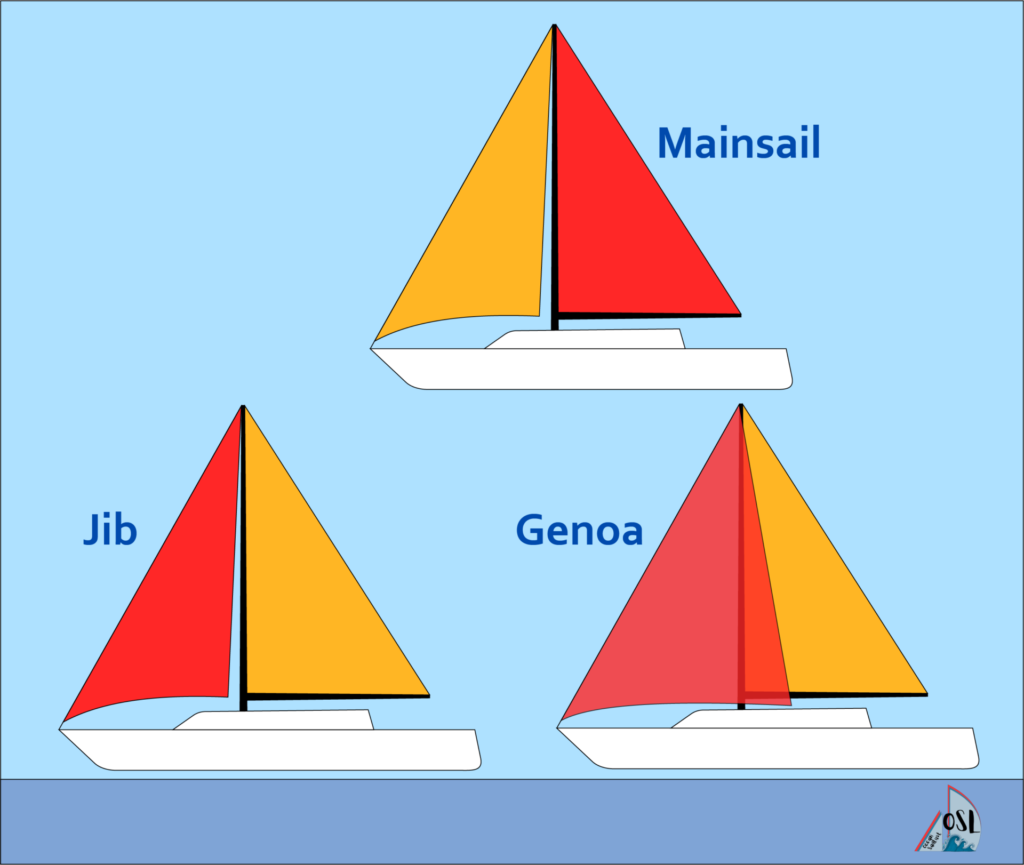
A headsail is any sail located forward of the mast on a sailing vessel. These sails are designed to work in conjunction with the main sail to provide optimal performance under varying wind conditions. There are several types of headsails available, each with its own unique characteristics and purposes.
One popular type of headsail is known as a genoa. This large foresail extends beyond the mast and overlaps with the main sail, providing additional power when sailing upwind or reaching across wind angles. Genoas come in various sizes ranging from 110% up to 150%, depending on how much overlap you want.
Another common type of headsail is called a jib. This smaller foresail does not overlap with the main sail but instead works in conjunction with it. The jib is typically used in higher wind conditions when a smaller sail area is needed to maintain control of the boat.
A staysail is a smaller sail located between the mast and the forestay. This type of headsail is typically used on larger boats to provide additional power when sailing upwind or reaching across wind angles. Staysails are often used in conjunction with other sails, such as a genoa or main sail.
Finally, there is also a mizzensail, which is located aft of the main mast on ketches and yawls. This sail provides additional power when sailing downwind or reaching across wind angles. Mizzensails come in various sizes and can be either fully battened or free-flying.
Lightwind Sails
Spinnaker sails are a type of downwind sail that can be used to increase boat speed when sailing in light winds. They are typically used in wind conditions below 10 knots, which are considered light air sails. Spinnakers come in two types: symmetrical and asymmetrical.

Symmetrical vs Asymmetrical Spinnaker
The symmetrical spinnaker is designed to sail directly downwind or with the wind coming from behind the boat. It is shaped like a balloon, with equal amounts of material on both sides of the sail. The sail is attached to a spinnaker pole, which extends out from the mast and holds the sail away from the boat.
Asymmetrical spinnakers, on the other hand, are designed for sailing at angles off the wind. They have an uneven shape, with more material on one side than the other. This design allows them to be flown without a spinnaker pole, making them easier to handle for smaller crews.
Another type of downwind sail is called a gennaker. Gennakers are similar to asymmetrical spinnakers but have a hybrid characteristic between a spinnaker and a genua. They are designed for reaching or running downwind at higher speeds than traditional cruising chutes or asymmetric spinnakers.
For those who prefer an even more user-friendly option than asymmetrical spinnakers or gennakers, parasailors might be what you’re looking for! A parasailor combines aspects of both a traditional spinnaker and a parachute into one easy-to-use package. The unique design of this sail makes it ideal for use in light winds when other sails may not perform well enough.
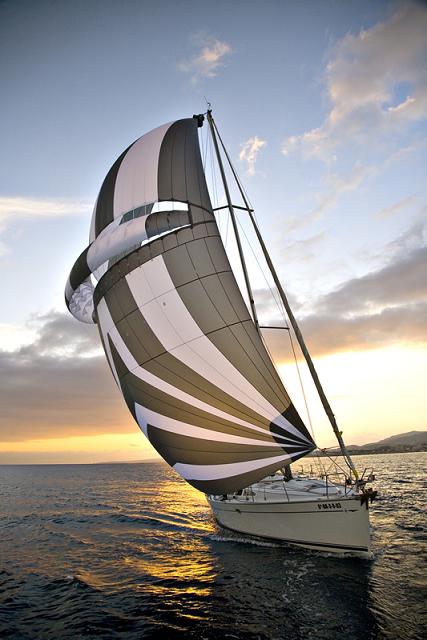
Finally, there’s another type of upwind/downwind sail called the code zero. Code zeros are designed to be used in light winds when sailing upwind, but they can also be used for reaching and running downwind. These sails have a flat shape that allows them to generate lift even in very light wind conditions.
Heavy Weather Sails
Heavy weather sailing is a challenging and potentially dangerous activity. The use of heavy weather sails, such as trysails, is crucial to ensure the safety of sailors and their vessels.
A trysail is a small triangular sail made of heavy-duty material, typically spinnaker cloth or other lightweight fabric. It is designed to be used in stormy weather conditions when winds are high and the seas are rough.
The role of a trysail is to provide an alternative source of propulsion when the main sail or jib cannot be used. In addition, it helps reduce the heeling effect on the vessel caused by strong winds. Trysails are rigged using a separate halyard and can be set up quickly when needed.
A trysail should be used in severe weather conditions when winds exceed 40 knots or more. It is recommended that sailors practice setting up their trysail before they need it so that they can do it quickly and efficiently in an emergency situation.

Another type of heavy weather sail that every sailor should have on board is a storm jib. This sail is typically much smaller than a regular jib and made from heavier materials such as Dacron or nylon. Its purpose is to provide additional stability during high wind speeds and rough seas.
The features of a storm jib include its size, shape, and weight distribution. It has a large luff (the leading edge) which allows it to be hoisted higher up on the rigging than other sails. This helps keep the boat stable during high-speed sailing in strong winds.
A storm jib should be used in extreme weather conditions where wind speeds exceed 50 knots or more. When using this sail, it is important to ensure that the halyard is properly tensioned and that the sail is sheeted in tightly. This will help prevent any unnecessary movement or fluttering of the sail.
Overview Common Sail Types
100% of mainsail
Light – High
100% of foretriangle
Moderate – High
triangular, overlapping
110% – 150% of foretriangle
Light – Moderate
60% – 80% of foretriangle
Close Reach – Broad Reach
Lightwind, Downwind
balloon shape, free flying
200% of mainsail (or even more)
Broad Reach, Running
parachute shape
100% of spinnaker
80% – 85% of spinnaker
Lightwind, Upwind
75% of spinnaker
30% – 60% of mainsail
Mainsail, heavy weather
17.5% of mainsail (or less)
Headsail, heavy weather
max. 65% of the hight of the foretriangle
Unconventional Sails
Wing sails are a type of sail design that is not commonly used in traditional sailboat designs. They are essentially vertical airfoils that generate lift and propulsion by directing the wind over the surface of the sail. Wing sails have become increasingly popular in modern sailing craft, particularly in high-performance racing boats.
One of the main advantages of wing sails is their ability to produce a significant amount of power with very little heeling force. This means that they can be used effectively in high-wind conditions without causing the boat to tip over. Additionally, wing sails are highly efficient at sailing upwind, which allows sailors to point higher into the wind than with other types of sails.
While wing sails may seem like a relatively new concept, they have actually been around for quite some time. The first recorded use of a wing sail was by German engineer Wolfgang Zimmermann in 1959. Since then, many different variations on the design have been developed and tested.

Kite sails are another unconventional type of sail that has gained popularity in recent years. Unlike traditional downwind sails such as spinnaker or parasailors, kite sails are flown from a line attached to the bow of the boat and do not require a mast or boom.
Sail Materials and Technology
Traditional sail materials.
Sails have been used for thousands of years to harness the power of the wind and propel boats across water. Traditional sail materials were flax, hemp, or cotton. These natural fibers were woven together to create a strong, yet flexible material that could withstand the harsh conditions at sea. However, as technology advanced and sailors began to demand more from their sails, new materials were developed.
Modern Sail Materials
Modern sailboats use synthetic materials such as polyester, nylon, or laminated fabrics for their sails. These materials are lightweight and incredibly strong, allowing sailors to achieve greater speeds with less effort. They are also more durable than traditional sail materials and can withstand prolonged exposure to sunlight and saltwater.
Popular Sail and Mast Configurations

The sloop rig is one of the most popular sail plans for modern sailboats. It features a single mast and one headsail, like a jib or genoa. The mainsail is typically triangular in shape and hoisted up the main mast using a backstay to support it. The jib or genoa is attached to the forestay that runs from the top of the mast to the bow of the boat.
Another popular sail plan is the cutter rig, which also features a single mast but has two headsails – an overlapping jib and a smaller staysail. The mainsail is still triangular in shape and hoisted up the main mast with a backstay for support.
Moving onto two-masted rigs, we have ketch rig, which features a main mast and a shorter mizzen mast located in front of the rudder. The mainsail is still triangular in shape and hoisted up the main mast with a backstay for support, while the mizzen sail is generally smaller and triangular or quadrilateral in shape.
Lastly, we have the yawl rig which is similar to the ketch rig but has its shorter mizzenmast located aft of the rudder. The mainsail is still triangular in shape and hoisted up the main mast with a backstay for support, while the mizzen sail is generally smaller and triangular or quadrilateral in shape.
Conclusion: Understanding the Different Types of Sails
Understanding the Different Types of Sails is crucial for any sailor who wants to optimize their performance and safety on the water. Whether you’re racing, cruising or simply enjoying a day out on your sailboat, having the right sails for the conditions can make all the difference.
Ultimately, understanding the different types of sails is essential for any sailor looking to improve their skills on the water. By selecting the right sail for your boat and conditions, you can optimize your performance while staying safe and comfortable during your time at sea.
So whether you’re a seasoned sailor or just starting out, take some time to explore the various types of sails available and find the ones that work best for you. With a little knowledge and experience under your belt, you’ll be well on your way to mastering this exciting sport!
Similar Posts

How do Boats Float? Exploring the Science Behind Buoyancy
Sailboats float because the average density of the boat is less than the density of water. When boats displace as much water as it weights, this is known as the buoyancy force generated by Archimedes’ principle. If you’ve ever wondered how do boats float and therefor enable us to embark on thrilling water adventures, you’ve…

Mainsail Furling Systems – Which one is right for you?
With the variety of options of mainsail furling systems available, including slab, in-boom, and in-mast systems, it can be challenging to determine which one best suits your needs. In this comprehensive guide, we will explore the pros and cons of each system, enabling you to make an informed decision that aligns with your sailing requirements….
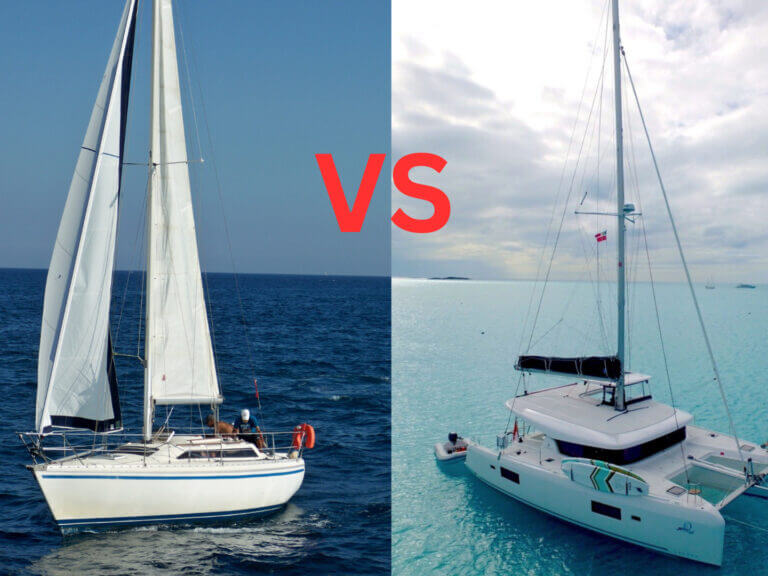
Monohulls vs. Catamarans: Which One is Best for You?
If you’re considering purchasing a sailboat, you might be wondering which type of vessel is best suited for your seafaring adventures. Fear not, for we’re here to help you weigh the differences between monohulls vs. catamarans to make an informed decision. Now, before we dive into the nitty-gritty details of hull design, sail handling, and…
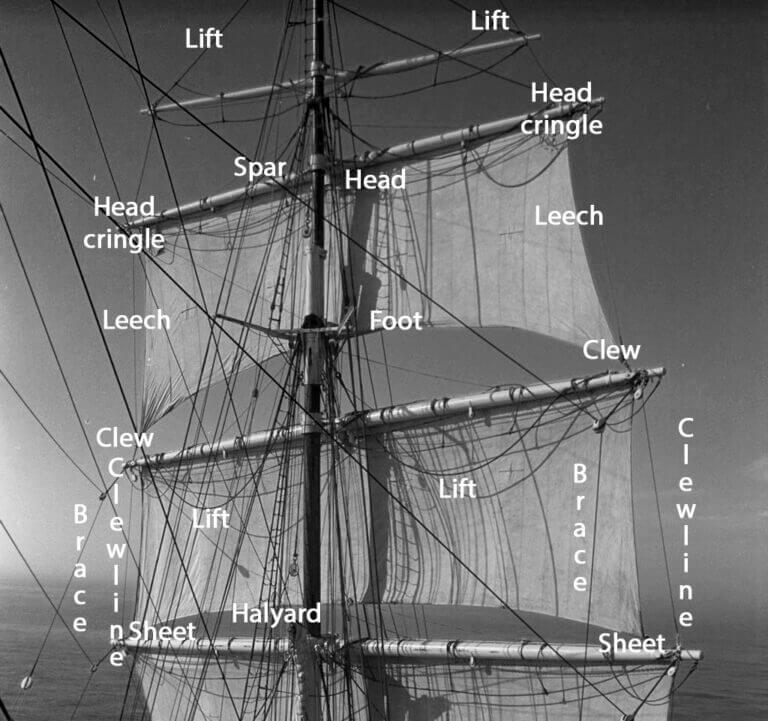

Whats the Difference between Standing Rigging and Running Rigging?
Running rigging refers to the movable lines and ropes used to control the position and shape of the sails on a sailboat. Standing rigging, on the other hand, refers to the fixed wires and cables that support the mast and keep it upright. As the sun rises on another day, we find ourselves immersed in…
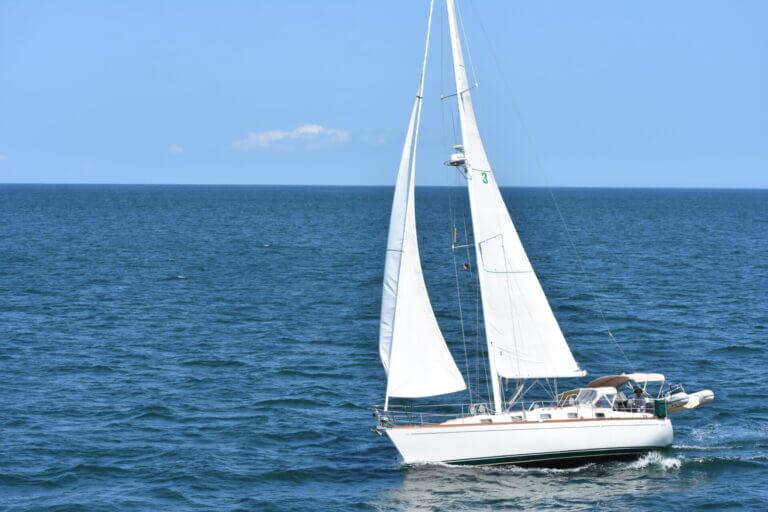
What is a Sloop? Definition, Types and History
A sloop is a type of sailboat that has a single mast and a fore-and-aft rig. Sloops are a type of sailboat that has been around for centuries. They are known for their versatility and ease of handling, making them popular among sailors of all skill levels. Sloops have a single mast and a fore-and-aft…
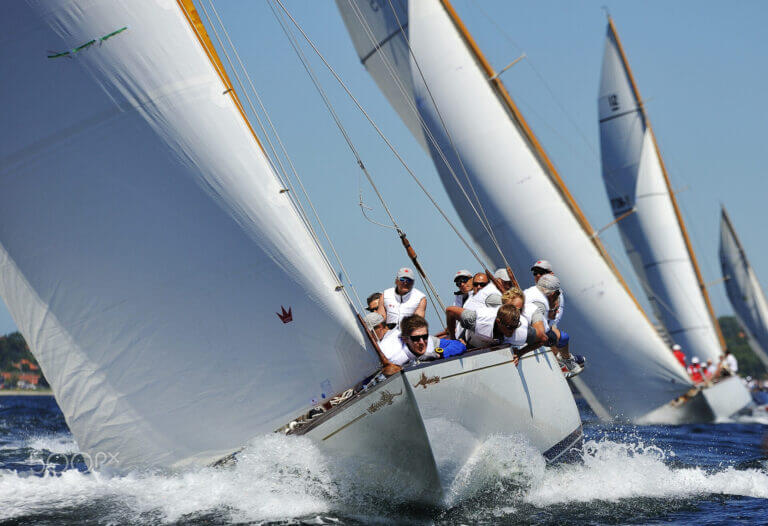
How Much Does Biofouling Slows Down your Boat?
Are you wondering how much biofouling can impact the performance of your sailboat? The amount of how much biofouling slows down a sailboat depends on various factors, such as the type of boat, its size, and the severity of the biofouling. On average, a sailboat with a heavily fouled hull can experience a reduction in…
The Ultimate Guide to Sail Types and Rigs (with Pictures)
What's that sail for? Generally, I don't know. So I've come up with a system. I'll explain you everything there is to know about sails and rigs in this article.
What are the different types of sails? Most sailboats have one mainsail and one headsail. Typically, the mainsail is a fore-and-aft bermuda rig (triangular shaped). A jib or genoa is used for the headsail. Most sailors use additional sails for different conditions: the spinnaker (a common downwind sail), gennaker, code zero (for upwind use), and stormsail.
Each sail has its own use. Want to go downwind fast? Use a spinnaker. But you can't just raise any sail and go for it. It's important to understand when (and how) to use each sail. Your rigging also impacts what sails you can use.

On this page:
Different sail types, the sail plan of a bermuda sloop, mainsail designs, headsail options, specialty sails, complete overview of sail uses, mast configurations and rig types.
This article is part 1 of my series on sails and rig types. Part 2 is all about the different types of rigging. If you want to learn to identify every boat you see quickly, make sure to read it. It really explains the different sail plans and types of rigging clearly.

Guide to Understanding Sail Rig Types (with Pictures)
First I'll give you a quick and dirty overview of sails in this list below. Then, I'll walk you through the details of each sail type, and the sail plan, which is the godfather of sail type selection so to speak.
Click here if you just want to scroll through a bunch of pictures .
Here's a list of different models of sails: (Don't worry if you don't yet understand some of the words, I'll explain all of them in a bit)
- Jib - triangular staysail
- Genoa - large jib that overlaps the mainsail
- Spinnaker - large balloon-shaped downwind sail for light airs
- Gennaker - crossover between a Genoa and Spinnaker
- Code Zero or Screecher - upwind spinnaker
- Drifter or reacher - a large, powerful, hanked on genoa, but made from lightweight fabric
- Windseeker - tall, narrow, high-clewed, and lightweight jib
- Trysail - smaller front-and-aft mainsail for heavy weather
- Storm jib - small jib for heavy weather
I have a big table below that explains the sail types and uses in detail .
I know, I know ... this list is kind of messy, so to understand each sail, let's place them in a system.
The first important distinction between sail types is the placement . The mainsail is placed aft of the mast, which simply means behind. The headsail is in front of the mast.
Generally, we have three sorts of sails on our boat:
- Mainsail: The large sail behind the mast which is attached to the mast and boom
- Headsail: The small sail in front of the mast, attached to the mast and forestay (ie. jib or genoa)
- Specialty sails: Any special utility sails, like spinnakers - large, balloon-shaped sails for downwind use
The second important distinction we need to make is the functionality . Specialty sails (just a name I came up with) each have different functionalities and are used for very specific conditions. So they're not always up, but most sailors carry one or more of these sails.
They are mostly attached in front of the headsail, or used as a headsail replacement.
The specialty sails can be divided into three different categories:
- downwind sails - like a spinnaker
- light air or reacher sails - like a code zero
- storm sails

The parts of any sail
Whether large or small, each sail consists roughly of the same elements. For clarity's sake I've took an image of a sail from the world wide webs and added the different part names to it:

- Head: Top of the sail
- Tack: Lower front corner of the sail
- Foot: Bottom of the sail
- Luff: Forward edge of the sail
- Leech: Back edge of the sail
- Clew: Bottom back corner of the sail
So now we speak the same language, let's dive into the real nitty gritty.
Basic sail shapes
Roughly speaking, there are actually just two sail shapes, so that's easy enough. You get to choose from:
- square rigged sails
- fore-and-aft rigged sails
I would definitely recommend fore-and-aft rigged sails. Square shaped sails are pretty outdated. The fore-and-aft rig offers unbeatable maneuverability, so that's what most sailing yachts use nowadays.

Square sails were used on Viking longships and are good at sailing downwind. They run from side to side. However, they're pretty useless upwind.
A fore-and-aft sail runs from the front of the mast to the stern. Fore-and-aft literally means 'in front and behind'. Boats with fore-and-aft rigged sails are better at sailing upwind and maneuvering in general. This type of sail was first used on Arabic boats.
As a beginner sailor I confuse the type of sail with rigging all the time. But I should cut myself some slack, because the rigging and sails on a boat are very closely related. They are all part of the sail plan .
A sail plan is made up of:
- Mast configuration - refers to the number of masts and where they are placed
- Sail type - refers to the sail shape and functionality
- Rig type - refers to the way these sails are set up on your boat
There are dozens of sails and hundreds of possible configurations (or sail plans).
For example, depending on your mast configuration, you can have extra headsails (which then are called staysails).
The shape of the sails depends on the rigging, so they overlap a bit. To keep it simple I'll first go over the different sail types based on the most common rig. I'll go over the other rig types later in the article.
Bermuda Sloop: the most common rig
Most modern small and mid-sized sailboats have a Bermuda sloop configuration . The sloop is one-masted and has two sails, which are front-and-aft rigged. This type of rig is also called a Marconi Rig. The Bermuda rig uses a triangular sail, with just one side of the sail attached to the mast.
The mainsail is in use most of the time. It can be reefed down, making it smaller depending on the wind conditions. It can be reefed down completely, which is more common in heavy weather. (If you didn't know already: reefing is skipper terms for rolling or folding down a sail.)
In very strong winds (above 30 knots), most sailors only use the headsail or switch to a trysail.

The headsail powers your bow, the mainsail powers your stern (rear). By having two sails, you can steer by using only your sails (in theory - it requires experience). In any case, two sails gives you better handling than one, but is still easy to operate.
Let's get to the actual sails. The mainsail is attached behind the mast and to the boom, running to the stern. There are multiple designs, but they actually don't differ that much. So the following list is a bit boring. Feel free to skip it or quickly glance over it.
- Square Top racing mainsail - has a high performance profile thanks to the square top, optional reef points
- Racing mainsail - made for speed, optional reef points
- Cruising mainsail - low-maintenance, easy to use, made to last. Generally have one or multiple reef points.
- Full-Batten Cruising mainsail - cruising mainsail with better shape control. Eliminates flogging. Full-length battens means the sail is reinforced over the entire length. Generally have one or multiple reef points.
- High Roach mainsail - crossover between square top racing and cruising mainsail, used mostly on cats and multihulls. Generally have one or multiple reef points.
- Mast Furling mainsail - sails specially made to roll up inside the mast - very convenient but less control; of sail shape. Have no reef points
- Boom Furling mainsail - sails specially made to roll up inside the boom. Have no reef points.
The headsail is the front sail in a front-and-aft rig. The sail is fixed on a stay (rope, wire or rod) which runs forward to the deck or bowsprit. It's almost always triangular (Dutch fishermen are known to use rectangular headsail). A triangular headsail is also called a jib .
Headsails can be attached in two ways:
- using roller furlings - the sail rolls around the headstay
- hank on - fixed attachment
Types of jibs:
Typically a sloop carries a regular jib as its headsail. It can also use a genoa.
- A jib is a triangular staysail set in front of the mast. It's the same size as the fore-triangle.
- A genoa is a large jib that overlaps the mainsail.
What's the purpose of a jib sail? A jib is used to improve handling and to increase sail area on a sailboat. This helps to increase speed. The jib gives control over the bow (front) of the ship, making it easier to maneuver the ship. The mainsail gives control over the stern of the ship. The jib is the headsail (frontsail) on a front-and-aft rig.
The size of the jib is generally indicated by a number - J1, 2, 3, and so on. The number tells us the attachment point. The order of attachment points may differ per sailmaker, so sometimes J1 is the largest jib (on the longest stay) and sometimes it's the smallest (on the shortest stay). Typically the J1 jib is the largest - and the J3 jib the smallest.
Most jibs are roller furling jibs: this means they are attached to a stay and can be reefed down single-handedly. If you have a roller furling you can reef down the jib to all three positions and don't need to carry different sizes.

Originally called the 'overlapping jib', the leech of the genoa extends aft of the mast. This increases speed in light and moderate winds. A genoa is larger than the total size of the fore-triangle. How large exactly is indicated by a percentage.
- A number 1 genoa is typically 155% (it used to be 180%)
- A number 2 genoa is typically 125-140%
Genoas are typically made from 1.5US/oz polyester spinnaker cloth, or very light laminate.

This is where it gets pretty interesting. You can use all kinds of sails to increase speed, handling, and performance for different weather conditions.
Some rules of thumb:
- Large sails are typically good for downwind use, small sails are good for upwind use.
- Large sails are good for weak winds (light air), small sails are good for strong winds (storms).
Downwind sails
Thanks to the front-and-aft rig sailboats are easier to maneuver, but they catch less wind as well. Downwind sails are used to offset this by using a large sail surface, pulling a sailboat downwind. They can be hanked on when needed and are typically balloon shaped.
Here are the most common downwind sails:
- Big gennaker
- Small gennaker
A free-flying sail that fills up with air, giving it a balloon shape. Spinnakers are generally colorful, which is why they look like kites. This downwind sail has the largest sail area, and it's capable of moving a boat with very light wind. They are amazing to use on trade wind routes, where they can help you make quick progress.
Spinnakers require special rigging. You need a special pole and track on your mast. You attach the sail at three points: in the mast head using a halyard, on a pole, and on a sheet.
The spinnaker is symmetrical, meaning the luff is as long as its leech. It's designed for broad reaching.

Gennaker or cruising spinnaker
The Gennaker is a cross between the genoa and the spinnaker. It has less downwind performance than the spinnaker. It is a bit smaller, making it slower, but also easier to handle - while it remains very capable. The cruising spinnaker is designed for broad reaching.
The gennaker is a smaller, asymmetric spinnaker that's doesn't require a pole or track on the mast. Like the spinnaker, and unlike the genoa, the gennaker is set flying. Asymmetric means its luff is longer than its leech.
You can get big and small gennakers (roughly 75% and 50% the size of a true spinnaker).
Also called ...
- the cruising spinnaker
- cruising chute
- pole-less spinnaker
- SpinDrifter
... it's all the same sail.

Light air sails
There's a bit of overlap between the downwind sails and light air sails. Downwind sails can be used as light air sails, but not all light air sails can be used downwind.
Here are the most common light air sails:
- Spinnaker and gennaker
Drifter reacher
Code zero reacher.
A drifter (also called a reacher) is a lightweight, larger genoa for use in light winds. It's roughly 150-170% the size of a genoa. It's made from very lightweight laminated spinnaker fabric (1.5US/oz).
Thanks to the extra sail area the sail offers better downwind performance than a genoa. It's generally made from lightweight nylon. Thanks to it's genoa characteristics the sail is easier to use than a cruising spinnaker.
The code zero reacher is officially a type of spinnaker, but it looks a lot like a large genoa. And that's exactly what it is: a hybrid cross between the genoa and the asymmetrical spinnaker (gennaker). The code zero however is designed for close reaching, making it much flatter than the spinnaker. It's about twice the size of a non-overlapping jib.

A windseeker is a small, free-flying staysail for super light air. It's tall and thin. It's freestanding, so it's not attached to the headstay. The tack attaches to a deck pad-eye. Use your spinnakers' halyard to raise it and tension the luff.
It's made from nylon or polyester spinnaker cloth (0.75 to 1.5US/oz).
It's designed to guide light air onto the lee side of the main sail, ensuring a more even, smooth flow of air.
Stormsails are stronger than regular sails, and are designed to handle winds of over 45 knots. You carry them to spare the mainsail. Sails
A storm jib is a small triangular staysail for use in heavy weather. If you participate in offshore racing you need a mandatory orange storm jib. It's part of ISAF's requirements.
A trysail is a storm replacement for the mainsail. It's small, triangular, and it uses a permanently attached pennant. This allows it to be set above the gooseneck. It's recommended to have a separate track on your mast for it - you don't want to fiddle around when you actually really need it to be raised ... now.

Why Use Different Sails At All?
You could just get the largest furling genoa and use it on all positions. So why would you actually use different types of sails?
The main answer to that is efficiency . Some situations require other characteristics.
Having a deeply reefed genoa isn't as efficient as having a small J3. The reef creates too much draft in the sail, which increases heeling. A reefed down mainsail in strong winds also increases heeling. So having dedicated (storm) sails is probably a good thing, especially if you're planning more demanding passages or crossings.
But it's not just strong winds, but also light winds that can cause problems. Heavy sails will just flap around like laundry in very light air. So you need more lightweight fabrics to get you moving.
What Are Sails Made Of?
The most used materials for sails nowadays are:
- Dacron - woven polyester
- woven nylon
- laminated fabrics - increasingly popular
Sails used to be made of linen. As you can imagine, this is terrible material on open seas. Sails were rotting due to UV and saltwater. In the 19th century linen was replaced by cotton.
It was only in the 20th century that sails were made from synthetic fibers, which were much stronger and durable. Up until the 1980s most sails were made from Dacron. Nowadays, laminates using yellow aramids, Black Technora, carbon fiber and Spectra yarns are more and more used.
Laminates are as strong as Dacron, but a lot lighter - which matters with sails weighing up to 100 kg (220 pounds).
By the way: we think that Viking sails were made from wool and leather, which is quite impressive if you ask me.
In this section of the article I give you a quick and dirty summary of different sail plans or rig types which will help you to identify boats quickly. But if you want to really understand it clearly, I really recommend you read part 2 of this series, which is all about different rig types.
You can't simply count the number of masts to identify rig type But you can identify any rig type if you know what to look for. We've created an entire system for recognizing rig types. Let us walk you through it. Read all about sail rig types
As I've said earlier, there are two major rig types: square rigged and fore-and-aft. We can divide the fore-and-aft rigs into three groups:
- Bermuda rig (we have talked about this one the whole time) - has a three-sided mainsail
- Gaff rig - has a four-sided mainsail, the head of the mainsail is guided by a gaff
- Lateen rig - has a three-sided mainsail on a long yard

There are roughly four types of boats:
- one masted boats - sloop, cutter
- two masted boats - ketch, schooner, brig
- three masted - barque
- fully rigged or ship rigged - tall ship
Everything with four masts is called a (tall) ship. I think it's outside the scope of this article, but I have written a comprehensive guide to rigging. I'll leave the three and four-masted rigs for now. If you want to know more, I encourage you to read part 2 of this series.
One-masted rigs
Boats with one mast can have either one sail, two sails, or three or more sails.
The 3 most common one-masted rigs are:
- Cat - one mast, one sail
- Sloop - one mast, two sails
- Cutter - one mast, three or more sails
1. Gaff Cat

2. Gaff Sloop

Two-masted rigs
Two-masted boats can have an extra mast in front or behind the main mast. Behind (aft of) the main mast is called a mizzen mast . In front of the main mast is called a foremast .
The 5 most common two-masted rigs are:
- Lugger - two masts (mizzen), with lugsail (cross between gaff rig and lateen rig) on both masts
- Yawl - two masts (mizzen), fore-and-aft rigged on both masts. Main mast much taller than mizzen. Mizzen without mainsail.
- Ketch - two masts (mizzen), fore-and-aft rigged on both masts. Main mast with only slightly smaller mizzen. Mizzen has mainsail.
- Schooner - two masts (foremast), generally gaff rig on both masts. Main mast with only slightly smaller foremast. Sometimes build with three masts, up to seven in the age of sail.
- Brig - two masts (foremast), partially square-rigged. Main mast carries small lateen rigged sail.

4. Schooner

5. Brigantine

This article is part 1 of a series about sails and rig types If you want to read on and learn to identify any sail plans and rig type, we've found a series of questions that will help you do that quickly. Read all about recognizing rig types
Related Questions
What is the difference between a gennaker & spinnaker? Typically, a gennaker is smaller than a spinnaker. Unlike a spinnaker, a gennaker isn't symmetric. It's asymmetric like a genoa. It is however rigged like a spinnaker; it's not attached to the forestay (like a jib or a genoa). It's a downwind sail, and a cross between the genoa and the spinnaker (hence the name).
What is a Yankee sail? A Yankee sail is a jib with a high-cut clew of about 3' above the boom. A higher-clewed jib is good for reaching and is better in high waves, preventing the waves crash into the jibs foot. Yankee jibs are mostly used on traditional sailboats.
How much does a sail weigh? Sails weigh anywhere between 4.5-155 lbs (2-70 kg). The reason is that weight goes up exponentially with size. Small boats carry smaller sails (100 sq. ft.) made from thinner cloth (3.5 oz). Large racing yachts can carry sails of up to 400 sq. ft., made from heavy fabric (14 oz), totaling at 155 lbs (70 kg).
What's the difference between a headsail and a staysail? The headsail is the most forward of the staysails. A boat can only have one headsail, but it can have multiple staysails. Every staysail is attached to a forward running stay. However, not every staysail is located at the bow. A stay can run from the mizzen mast to the main mast as well.
What is a mizzenmast? A mizzenmast is the mast aft of the main mast (behind; at the stern) in a two or three-masted sailing rig. The mizzenmast is shorter than the main mast. It may carry a mainsail, for example with a ketch or lugger. It sometimes doesn't carry a mainsail, for example with a yawl, allowing it to be much shorter.
Special thanks to the following people for letting me use their quality photos: Bill Abbott - True Spinnaker with pole - CC BY-SA 2.0 lotsemann - Volvo Ocean Race Alvimedica and the Code Zero versus SCA and the J1 - CC BY-SA 2.0 Lisa Bat - US Naval Academy Trysail and Storm Jib dry fit - CC BY-SA 2.0 Mike Powell - White gaff cat - CC BY-SA 2.0 Anne Burgess - Lugger The Reaper at Scottish Traditional Boat Festival
Hi, I stumbled upon your page and couldn’t help but notice some mistakes in your description of spinnakers and gennakers. First of all, in the main photo on top of this page the small yacht is sailing a spinnaker, not a gennaker. If you look closely you can see the spinnaker pole standing on the mast, visible between the main and headsail. Further down, the discription of the picture with the two German dinghies is incorrect. They are sailing spinnakers, on a spinnaker pole. In the farthest boat, you can see a small piece of the pole. If needed I can give you the details on the difference between gennakers and spinnakers correctly?
Hi Shawn, I am living in Utrecht I have an old gulf 32 and I am sailing in merkmeer I find your articles very helpful Thanks
Thank you for helping me under stand all the sails there names and what there functions were and how to use them. I am planning to build a trimaran 30’ what would be the best sails to have I plan to be coastal sailing with it. Thank you
Hey Comrade!
Well done with your master piece blogging. Just a small feedback. “The jib gives control over the bow of the ship, making it easier to maneuver the ship. The mainsail gives control over the stern of the ship.” Can you please first tell the different part of a sail boat earlier and then talk about bow and stern later in the paragraph. A reader has no clue on the newly introduced terms. It helps to keep laser focused and not forget main concepts.
Shawn, I am currently reading How to sail around the World” by Hal Roth. Yes, I want to sail around the world. His book is truly grounded in real world experience but like a lot of very knowledgable people discussing their area of expertise, Hal uses a lot of terms that I probably should have known but didn’t, until now. I am now off to read your second article. Thank You for this very enlightening article on Sail types and their uses.
Shawn Buckles
HI CVB, that’s a cool plan. Thanks, I really love to hear that. I’m happy that it was helpful to you and I hope you are of to a great start for your new adventure!
Hi GOWTHAM, thanks for the tip, I sometimes forget I haven’t specified the new term. I’ve added it to the article.
Nice article and video; however, you’re mixing up the spinnaker and the gennaker.
A started out with a question. What distinguishes a brig from a schooner? Which in turn led to follow-up questions: I know there are Bermuda rigs and Latin rig, are there more? Which in turn led to further questions, and further, and further… This site answers them all. Wonderful work. Thank you.
Great post and video! One thing was I was surprised how little you mentioned the Ketch here and not at all in the video or chart, and your sample image is a large ship with many sails. Some may think Ketch’s are uncommon, old fashioned or only for large boats. Actually Ketch’s are quite common for cruisers and live-aboards, especially since they often result in a center cockpit layout which makes for a very nice aft stateroom inside. These are almost exclusively the boats we are looking at, so I was surprised you glossed over them.
Love the article and am finding it quite informative.
While I know it may seem obvious to 99% of your readers, I wish you had defined the terms “upwind” and “downwind.” I’m in the 1% that isn’t sure which one means “with the wind” (or in the direction the wind is blowing) and which one means “against the wind” (or opposite to the way the wind is blowing.)
paul adriaan kleimeer
like in all fields of syntax and terminology the terms are colouual meaning local and then spead as the technology spread so an history lesson gives a floral bouque its colour and in the case of notical terms span culture and history adds an detail that bring reverence to the study simply more memorable.
Hi, I have a small yacht sail which was left in my lock-up over 30 years ago I basically know nothing about sails and wondered if you could spread any light as to the make and use of said sail. Someone said it was probably originally from a Wayfayer wooden yacht but wasn’t sure. Any info would be must appreciated and indeed if would be of any use to your followers? I can provide pics but don’t see how to include them at present
kind regards
Leave a comment
You may also like, 17 sailboat types explained: how to recognize them.
Ever wondered what type of sailboat you're looking at? Identifying sailboats isn't hard, you just have to know what to look for. In this article, I'll help you.

How Much Sailboats Cost On Average (380+ Prices Compared)
Own your first boat within a year on any budget.
A sailboat doesn't have to be expensive if you know what you're doing. If you want to learn how to make your sailing dream reality within a year, leave your email and I'll send you free updates . I don't like spam - I will only send helpful content.
Ready to Own Your First Boat?
Just tell us the best email address to send your tips to:
Different Types of Sails: A Comprehensive Guide
by Emma Sullivan | Aug 4, 2023 | Sailboat Racing
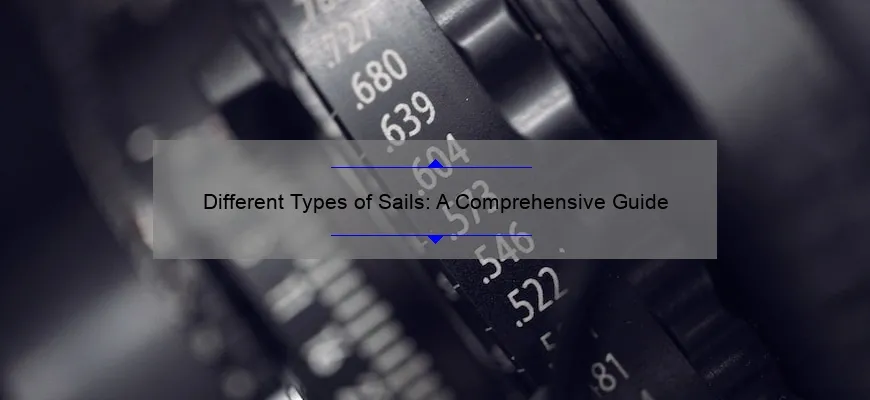
Short answer different types of sails:
There are several different types of sails used in sailing, including mainsails, headsails (jibs and genoas), spinnakers, gennakers, and storm sails. Each type is designed for specific wind conditions and sailing techniques, contributing to the overall performance and maneuverability of a sailboat.
Understanding the Basics: Exploring Different Types of Sails
Sailing enthusiasts and beginners alike can attest to the exhilaration that comes with gliding across the water, propelled by nothing but the wind. But what many may not realize is that behind this seemingly effortless endeavor lies a world of intricately designed sails, each with its own purpose and unique characteristics. In this blog post, we will dive into the basics of sail types, shedding light on their features, functions, and how they contribute to sailing performance.
Let’s start by familiarizing ourselves with some fundamental sail designs commonly seen on boats:
1. Mainsail: The mainsail is perhaps the most essential sail on a boat as it generates a bulk of the driving force. It is typically positioned behind the mast and spans from the top to bottom of it. This triangular-shaped sail can be adjusted using a combination of ropes or lines called “sheets” to optimize its performance in various wind conditions.
2. Jib: The jib is a fore-sail that complements the mainsail’s power by capturing additional wind forward of the mast. Smaller in size compared to the mainsail, it helps maintain balance and maneuverability while sailing upwind or at higher speeds.
3. Genoa: Similar in purpose to a jib, a genoa is an even larger fore-sail used mainly for cruising yachts or racing boats when sailing downwind or broad-reaching. Its expansive size allows for increased surface area exposure to capture more wind energy efficiently .
4. Spinnaker: When it comes to downwind sailing at maximum speed potential, no sail compares to the spinnaker. This specialized asymmetrical sail is typically shaped like a parachute or balloon and catches wind from opposite sides due to its distinct cut and attachment points known as “guys” and “sheets.” Its remarkable ability to generate substantial lift enables sailors to maximize boat speed under specific conditions.
Now that we have acquainted ourselves with popular sail types let us explore some key factors to consider when choosing the right sail for specific sailing conditions:
1. Wind Speed: Different sails are designed to excel in varying wind speeds. Light airs call for smaller, more maneuverable sails like jibs or genoas, while heavy winds necessitate robust sails that can withstand the force without overpowering the boat.
2. Point of Sail: Depending on whether you are sailing upwind, downwind, or reaching across the wind, certain sails will be more effective than others. Jibs and genoas perform best when beating into the wind (upwind), while spinnakers excel when sailing downwind.
3. Boat Type and Rigging: The optimal sail type is also influenced by the size, weight, and rigging of your vessel. Cruising boats may benefit from larger fore-sails like genoas for added power during long passages, whereas racing boats might require a range of specialized sails to optimize speed and performance in different courses.
4. Crew Ability: Consider your crew’s experience level and physical capability when selecting sails . Smaller crews may prefer easier-to-handle sails that offer better control with fewer adjustments necessary.
It is important to note that this blog post only scratches the surface of sail types and their applications—there is a wealth of additional information available for those looking to delve deeper into this fascinating realm of sailing. However, armed with this basic understanding, beginners can embark on their voyages with confidence while seasoned sailors can continue honing their expertise in maximizing sail efficiency.
So next time you set foot on a sailing vessel, take a moment to appreciate not only the sheer beauty of billowing canvas but also the remarkable science behind it all—a harmonious blend of craftsmanship and skillful navigation through various types of sails designed to harness nature’s power as efficiently as possible. May fair winds always be at your back!
Setting Sail: How Different Types of Sails Impact Your Voyage
Embarking on a sailing adventure can be an exhilarating experience, filled with the promise of new horizons and exciting discoveries. But before you set sail, it’s crucial to understand how different types of sails can impact your journey. Whether you’re a seasoned sailor or a nautical newbie, this in-depth guide will shed light on the various sail types and their effects on your voyage. So grab your compass and brace yourself for a captivating exploration into the world of sails!
At first glance, all sails may appear similar – large pieces of fabric designed to catch the wind and propel your vessel forward. However, each sail is uniquely tailored to optimize performance under specific conditions. Let’s dive deeper into three prominent sail types: mainsails, genoas/jibs, and spinnakers.
The mainsail is crucial for propulsion when sailing upwind or close-hauled against the wind direction. Positioned behind the mast, it captures force from astern by redirecting it onto a foil-shaped surface—a process known as “lift.” This lift generates forward thrust that propels the boat through water efficiently . Mainsails come in various configurations such as Bermuda rigging, gaff rigging, or even more advanced square-top options that enhance aerodynamic efficiency .
Next up are genoas/jibs – versatile sails commonly used when sailing off-wind (downwind) or reaching across the wind at broader angles. These front-facing triangular sails attach to the forestay (a cable/wire that supports the mast) and work alongside other foresails to maximize performance under differing wind strengths. The larger genoas excel at capturing more wind power in lighter breezes with their greater surface area while smaller jibs prove ideal for heavier winds since they provide better control and maneuverability.
Lastly, we have spinnakers – vibrant symbols of downwind sailing renowned for their vivid colors and graceful ballooning shapes. These uniquely designed sails are deployed when the wind is blowing from the sides or stern of the boat . Spinnakers dramatically increase sail area, offering immense power for downwind speed. By creating a larger pressure differential between the two sides of the sail , they generate thrust that propels your vessel forward like a kite in the sky.
Now, let’s consider how these various sail types impact your voyage based on prevailing wind conditions . When heading into an upwind battle against strong winds, a mainsail with its efficient lift will optimize propulsion and help navigate smoothly through challenging waters . As winds shift or decrease intensity, switching to smaller jibs or genoas ensures better control and improved maneuvering capabilities.
On those calm, sunny days when peaceful sailing is preferred, unfurling a colorful spinnaker will bring exhilaration to your journey. The increased sail area catches even the slightest breeze, providing ample power for a relaxing downwind cruise while adding visual appeal to your boating experience.
Additionally, mastering the art of sail trimming – adjusting and shaping sails according to wind direction and strength – combines science and finesse to maximize performance. Understanding each sail type’s unique characteristics allows you to optimize efficiency and harness every gust of wind in your favor.
As seasoned sailors know all too well, selecting the right combination of sails for different conditions can make or break a voyage. Having knowledge of these fundamental aspects transforms simple fabric into powerful tools that dictate triumph over adversity at sea .
In conclusion, understanding how different types of sails impact each voyage empowers sailors to adapt effectively as situations change on the open water. From maximizing efficiency with mainsails during upwind journeys to embracing downwind adventures with spinnakers flapping vibrantly in the breeze – each sail plays an integral role in optimizing performance while captivating our sense of adventure along the way. So next time you set foot aboard a sailing vessel , remember that it’s not just wind filling those sails, but a rich tapestry of knowledge and strategy propelling you towards your maritime dreams. Bon voyage!
Breaking it Down: A Step-by-Step Guide to Different Types of Sails
Ah, the beauty of sailing! Picture yourself cruising through the open waters, wind in your hair, and the sails billowing high above you. But have you ever wondered about the different types of sails that allow sailboats to glide effortlessly through the seas? Well, wonder no more! In this step-by-step guide, we will unravel the mysteries behind various types of sails, giving you an insight into their functionality and purpose.
1. Main Sail:
Let’s start with the star of the show – the main sail . Positioned at the stern (back) of a sailboat, this majestic sail is responsible for harnessing the mighty power of wind and converting it into propulsive force. The main sail usually features a triangular shape held upright by a mast and boom (horizontal spar). Its size can vary depending on boat size and design requirements . So next time you spot that classic triangle soaring above a vessel, remember that it’s all about capturing nature’s breath to propel you forward!
2. Jib Sail:
Now let’s move forward to another essential sail type – the jib sail . Located at the bow (front) of a sailboat, this smaller triangular-shaped sail works in conjunction with the main sail to maximize efficiency and control. While its primary function is aiding in steering by providing lateral lift and balance when tacking against or running with the wind, it also assists in generating forward momentum.
Prepare yourself for an upgrade! The genoa is essentially an enlarged version of a jib sail that extends beyond a boat’s mast and overlaps with its mainsail. Often seen on racing yachts or larger cruising boats, this impressive rectangular-shaped headsail provides additional power in lighter winds while enabling increased maneuverability close-hauled. So when you witness those sleek racing vessels gliding swiftly on water before your eyes, the genoa is surely playing its part to perfection.
4. Spinnaker:
Let’s add a touch of excitement to the mix with the spinnaker ! This distinctive and colorful sail is designed for downwind sailing, offering unparalleled speed and grace when sailing with the wind at your back. Shaped like a large balloon, it takes full advantage of air movement to unleash the boat’s potential in light breezes. However, be warned – handling a spinnaker requires skill and precision due to its enormous size and delicate nature!
5. Cutter Rig:
Last but not least, let’s explore an arrangement commonly seen on cruising boats – the cutter rig . This configuration involves multiple headsails that work together harmoniously to provide flexibility under various wind conditions. Picture a main sail combined with two or more foresails (jib or genoa) of varying sizes, enabling sailors to adapt swiftly according to changing windspeeds or points of sail . The cutter rig offers versatility on extended voyages or when exploring unpredictable waters, making it a favorite among adventurous seafarers.
Now that you have taken this step-by-step journey through different types of sails, you can appreciate their rich history, purposeful designs, and unique contributions to sailing prowess. Whether you’re an aspiring sailor or simply fascinated by these marvelous creations, remember that each sail has its own story to tell while propelling us towards thrilling adventures on the high seas!
Frequently Asked Questions About Different Types of Sails, Answered!
When it comes to sailing, a crucial element that determines your boat’s performance and maneuverability is the type of sails you choose. Whether you are a seasoned sailor or just getting started, understanding the different types of sails available can greatly enhance your sailing experience. In this article, we will address some frequently asked questions about various types of sails, providing you with detailed professional information while infusing a touch of wit and cleverness.
1. What are the different types of sails commonly used in sailing?
Ahoy! There are several key types of sails used by sailors worldwide. The most common ones include mainsails, genoas/jibs, spinnakers, and foresails/staysails. These sails differ in size, shape, and purpose – each serving its unique role on the high seas.
2. What is the purpose of a mainsail?
The mainsail is like the captain at the helm; it plays a central role in propelling your boat forward. It is usually triangular or quadrilateral in shape and mounted on the mainmast. Mainsails generate power by catching wind from behind to propel your vessel forward efficiently .
3. Is there a difference between genoas and jibs? I’ve heard both terms being used interchangeably.
Ah! Here’s where it gets interesting – genoas and jibs might seem like twins separated at birth, but they do have distinct characteristics (just like two sailors with contrasting personalities). A jib refers to any sail located forward of the mast while attached to its own stay(s), whereas a genoa specifically refers to larger headsails overlapping the mast from behind.
4. Spinnaker…what’s all the fuss about?
Ahoy matey! If you want to add some excitement to your sailing adventure or create an eye-catching spectacle for those ashore, then unfurling a spinnaker is the way to go! This sail is designed for downwind sailing, embracing the wind like a butterfly in flight. Shaped like a colorful parachute, it captures the breeze and efficiently propels your boat while providing that adrenaline rush all sailors secretly crave.
5. I keep hearing about foresails and staysails – what exactly are they?
Avast ye! Foresails and staysails are smaller sails found towards the bow of your vessel. While foresails refer to any sail forward of the mainsail, staysails specifically attach to their own forestays or wire ropes for support. These sails add versatility to your sailing options by enabling maneuverability even in changing weather conditions .
Remember, matey, understanding each sail’s unique purpose is key to becoming a master sailor!
In conclusion, we’ve shed some light on frequently asked questions regarding different types of sails used in sailing endeavors. The mainsail leads the charge, while genoas and jibs battle for distinctly similar identities. Spinnakers create an awe-inspiring display on calm waters, with foresails and staysails ensuring sailors remain nimble no matter the weather conditions . So hoist those sails high, catch that wind just right, and set off on memorable seafaring adventures like a true salty dog!
Harnessing the Wind: The Advantages and Disadvantages of Various Sail Designs
Sailing has long been a fascinating and exhilarating way to harness the power of the wind for transportation or recreational purposes. As enthusiasts, sailors, and engineers continue to explore new sail designs to improve efficiency and maneuverability, it is essential to delve into the advantages and disadvantages that each design brings to the table. In this blog post, we will take a detailed look at various sail designs, exploring their professional attributes while injecting some wit and cleverness along the way.
1. Traditional Square Sail: Let’s kick things off with a classic! The traditional square sail dates back centuries and can be seen adorning historical ships like the majestic tall ships from centuries ago. With its large surface area, these sails excel in capturing wind from multiple directions, ensuring optimal maneuverability. However, their main drawback lies in their inability to effectively sail against the wind (upwind sailing). So unless you have plans for a one-way trip with a favorable breeze at your back all day long, you might find yourself yearning for better options.
2. Fore-and-Aft Sail: Ahoy mates! Here comes one versatile design: the fore-and-aft sail. With its unique orientation parallel to a vessel’s keel line, these triangular sails allow sailing efficiently both upwind and downwind – talk about being dynamic! Furthermore, they provide excellent control with adjustable angles relative to wind direction (thanks to their elaborate rigging systems). On top of that, these sails are known for their elegant appearance – perfect for sea adventurers who enjoy turning heads on open waters. However, don’t be fooled by their versatility; fore-and-aft sails tend to have limited effectiveness when it comes to reaching speed records due to relatively smaller surface areas.
3. Spinnaker Sail: If speed is your game (and why wouldn’t it be?), then behold the spinnaker sail ! Designed specifically for downwind sailing, this beauty is all about maximizing speed by capturing the wind’s power even when it seems unwilling to cooperate. Its large, billowing shape acts as a parachute, propelling your vessel forward as you surf on waves of pure velocity. However, mastering the art of deploying and controlling a spinnaker sail requires expertise and finesse – otherwise, you might end up tangled in a web of fabric and despair faster than you can say “avast!”
4. Wing Sail: Innovation ahoy! Brace yourselves for the future of sail design: the wing sail . Inspired by aircraft dynamics, this sleek creation mimics an airplane wing in both construction and efficiency. With its solid, non-flexible surface material (think rigid sailcloth or carbon fiber), wing sails offer a whole new level of stability even in severe winds. They also provide great control while reducing drag and heeling (tilting) moments – making your journey smoother than butter on deck toast! Alas, obtaining or retrofitting a vessel to accommodate these futuristic sails can be quite costly.
5. Soft Wing Sails: As any savvy sailor knows—balance is key between luxury (cost) and performance enhancement! Enter soft wing sails—a hybrid approach combining elements from traditional sails with modern ingenuity. These state-of-the-art sails feature segmented sections that mimic the behavior and control offered by traditional wing sails at a fraction of the cost. Additionally, their lightweight construction ensures ease of use without compromising maneuverability—perfect for those seeking performance improvements while keeping their wallet afloat.
In conclusion, exploring various sail designs not only illuminates the possibilities within our grasp but also highlights their distinct advantages and disadvantages. Traditional square sails bring heritage and nostalgia; fore-and-aft sails offer versatility with elegance; spinnaker sails propel us to unparalleled speeds; wing sails bring stability fit for tomorrow’s sailors; while soft wing designs merge affordability and performance. So hoist your chosen sails high, fellow adventurers, and may the wind forever be at your back as you embark on uncharted waters!
Sailing the Seas: Discovering the Perfect Sail for Your Needs
Title: Sailing the Seas: Unveiling the Perfect Sail to Steer Your Course
Introduction: Sailing enthusiasts often find themselves caught in a whirlwind of excitement and anticipation when it comes to choosing that perfect sail . Whether you’re an experienced sailor or just beginning to dip your toes into this captivating world, finding the ideal sail tailored to your needs can make all the difference between an ordinary voyage and an extraordinary adventure. In this blog post, we embark on a journey to uncover the secrets behind selecting the perfect sail for every sailing endeavor.
1. Understanding Your Needs: The Sail’s Role When setting out on a voyage, understanding your individual needs is paramount. Just as no two captains are alike, no single sail can fulfill everyone’s requirements. Are you looking for enhanced speed, versatility, durability or maneuverability? Answering these crucial questions will guide us towards identifying the most suitable sail configuration capable of translating your sailing dreams into reality.
2. The Art of Sizing: Finding Harmony with Mother Nature To match our ambitions with reality, we must turn our gaze towards sizing sails aptly. Sail size plays a significant role in harnessing nature’s power effectively while ensuring safety at sea remains uncompromised. A perfectly sized sail should be appropriately shaped – neither too large nor too small – allowing it to efficiently convert wind energy into forward motion without overwhelming its crew.
3. The Pursuit of Performance: Design Innovations Innovation knows no bounds in today’s fast-evolving sailing industry! Manufacturers push boundaries and introduce advanced design features aimed at optimizing performance on the seas. From hydrodynamic shapes engineered for reduced drag to innovative materials imbued with strength and endurance, contemporary sails are designed to satisfy even discerning sailors seeking unrivaled performance.
4. Decoding Materials: Fabrics That Weather Every Storm Choosing the right fabric material is akin to handpicking armor for battle; it must withstand nature’s fury while withstanding the test of time. Dacron, Kevlar, carbon fiber, and Mylar are just a few of the materials available to sailors today, each possessing unique characteristics that cater to diverse sailing preferences. Dive into the sea of possibilities as we unravel their strengths and weaknesses.
5. The Shape of Things: An Aerodynamic Symphony A sail’s shape is like a finely crafted instrument in an orchestra; it must respond harmoniously to the rhythm of wind. Hollowed curves, twisted profiles, cambered sections – modern sail design encompasses a plethora of aerodynamic concepts aimed at achieving peak performance optimization while enhancing stability and control over your vessel. We’ll explore these concepts and how they can elevate your seafaring experience.
6. Beyond the Basics: Specialty Sails for Every Occasion Just as every sailor possesses their own unique style and approach to sailing, there exist sails specially designed for specific purposes beyond regular cruising or racing. Spinnakers, gennakers, code zero sails – these specialty sails add an extra dimension to your repertoire on different points of sail.Embark with us on a voyage deep into sail classification as we unveil these gems tailored for every seafaring endeavor.
Conclusion: Sailing is an ancient art intertwined with both passion and science; finding the perfect sail unveils limitless possibilities on the seas before you. By understanding your needs, sizing appropriately, embracing technology advancements in design and materials, adhering to aerodynamic principles, and exploring specialized sails when necessary, you embark upon a journey where nature’s winds become your ally in conquering vast oceans. So set course on this exciting adventure today – discover the perfect sail that will carry you towards unforgettable horizons!
Recent Posts
- Approaching a Mooring Buoy: Essential Tips for Safe Navigation
- Best Tiller Autopilot: Enhance Your Sailing Experience
- Nautical Navigator: Essential Tools and Techniques for Seamanship
- Sail Making Material: A Comprehensive Guide
- 2 Person Dinghy: The Ultimate Guide to Choosing the Perfect Boat
- Sailboat Gear and Equipment
- Sailboat Lifestyle
- Sailboat Maintenance
- Sailboat Racing
- Sailboat Tips and Tricks
- Sailboat Types
- Sailing Adventures
- Sailing Destinations
- Sailing Safety
- Sailing Techniques

IMAGES
VIDEO
COMMENTS
The mainsail, headsail (or jib), genoa, spinnaker, and gennaker are the most popular types of sails on sailboats. There are also a number of different configurations when considering the type of sail and mast in use including a sloop, fractional rig sloop, cutter, ketch, schooner, yawl, and cat.
Table of Contents. Different Types of Sails on a Sailboat: Why Use Different Sails at All? Different Sail Types for Different Wind Conditions. Sail Plans: Different Combinations for Different Boats. Understanding Sail Anatomy. The Head: The Top of the Sail. The Tack: The Lower Front Corner of the Sail. The Foot: The Bottom of the Sail.
Most sailboats have one mainsail and one headsail. Typically, the mainsail is a fore-and-aft bermuda rig (triangular shaped). A jib or genoa is used for the headsail. Most sailors use additional sails for different conditions: the spinnaker (a common downwind sail), gennaker, code zero (for upwind use), and stormsail.
Different Sail Types Explained (9 Types of Sails) Improve Sailing. 19.7K subscribers. Subscribed. 4.9K. 202K views 5 years ago Sailboats Explained - Beginners Guide to Sailboats, Parts, and...
There are several different types of sails used in sailing, including mainsails, headsails (jibs and genoas), spinnakers, gennakers, and storm sails. Each type is designed for specific wind conditions and sailing techniques, contributing to the overall performance and maneuverability of a sailboat.